Operation Guide 3135 3206
1
MO0909-EA
Getting Acquainted
Congratulations upon your selection of this CASIO watch. To get the most out
of your purchase, be sure to read this manual carefully.
Applications
The built-in sensors of this watch measure direction, barometric pressure,
temperature and altitude. Measured values are then shown on the display.
Such features make this watch useful when hiking, mountain climbing, or
when engaging in other such outdoor activities.
Warning!
• The measurement functions built into this watch are not intended for
taking measurements that require professional or industrial precision.
Values produced by this watch should be considered as reasonable
representations only.
• The Moon phase indicator and tide graph data that appear on the
display of this watch are not intended for navigation purposes. Always
use proper instruments and resources to obtain data for navigation
purposes.
• This watch is not an instrument for calculating low tide and high tide
times. The tide graph of this watch is intended to provide a reasonable
approximation of tidal movements only.
• When engaging in mountain climbing or other activities in which losing
your way can create a dangerous or life-threatening situation, always be
sure to use a second compass to confirm direction readings.
• Note that CASIO COMPUTER CO., LTD. assumes no responsibility for
any damage or loss suffered by you or any third party arising through
the use of this product or its malfunction.
Keep the watch exposed to bright light
The electricity generated by the solar cell of the
watch is stored by a built-in battery. Leaving or
using the watch where it is not exposed to light
causes the battery to run down. Make sure the
watch is exposed to light as much as possible.
• When you are not wearing the watch on your
wrist, position the face so it is pointed at a
source of bright light.
• You should try to keep the watch outside of
your sleeve as much as possible. Charging is
reduced significantly if the face is covered only
partially.
l
l
l
l
l
l
l
l
l
l
l
Bright light
Solar cell
• The watch continues to operate, even when it is not exposed to light.
Leaving the watch in the dark can cause the battery to run down, which will
result in some watch functions being disabled. If the battery goes dead, you
will have to re-configure watch settings after recharging. To ensure normal
watch operation, be sure to keep it exposed to light as much as possible.
Bright light
Electrical
energy
All
functions
enabled
LEVEL 1
LEVEL 2
LEVEL 3
LEVEL 4
Charge
Solar cell
(Converts light to
electrical power.)
Rechargeable battery
LEVEL 1
LEVEL 2
LEVEL 3
LEVEL 4
Some
functions
disabled
Dis-
charge
Battery charges in the light. Battery discharges in the dark.
• The actual level at which some functions are disabled depends on the
watch model.
• Frequent display illumination can run down the battery quickly and require
charging. The following guidelines give an idea of the charging time
required to recover from a single illumination operation.
Approximately five minutes exposure to bright sunlight coming in through
a window
Approximately 50 minutes exposure to indoor fluorescent lighting
• Be sure to read “Power Supply” for important information you need to
know when exposing the watch to bright light.
If the display of the watch is blank...
If the display of the watch is blank, it means that the watch’s Power Saving
function has turned off the display to conserve power.
• See “Power Saving” for more information.
About This Manual
• Depending on the model of your watch, display
text appears either as dark figures on a light
background (Module 3135), or light figures on a
dark background (Module 3206). All sample
displays in this manual are shown using dark
figures on a light background.
• Button operations are indicated using the
letters shown in the illustration.
• Each section of this manual provides you with
the information you need to perform operations
in each mode. Further details and technical
information can be found in the “Reference”
section.
(Light)
Module 3135
Module 3206
General Guide
• The illustration below shows which buttons you need to press to navigate
between modes.
• In any mode, press L to illuminate the display.
• You can use buttons A, B, and C to enter a sensor mode directly from
the Timekeeping Mode or from another sensor mode. To enter a sensor
mode from the Tide/Moon Data, Countdown Timer, Stopwatch, World Time,
Alarm, or Data Recall Mode, first enter the Timekeeping Mode and then
press the applicable button.
Timekeeping Mode
Altimeter Mode
Stopwatch
Mode
Countdown
Timer Mode
Digital
Compass Mode
Press D.
Press B.
Alarm Mode
Press
D.
▲
Press C.
Sensor Modes
World Time Mode
Barometer/
Thermometer Mode
Press A.
Data Recall
Mode
▲
▲
▲
▲
l
l
l
l
l
l
l
l
l
l
l
l
l
Tide/Moon Data
Mode
▲
▲
▲
▲
▲
▲

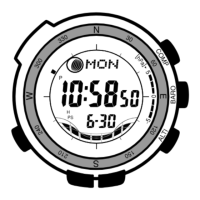
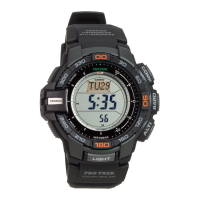

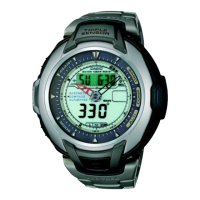
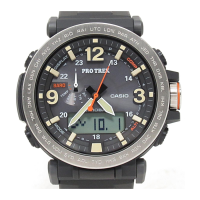
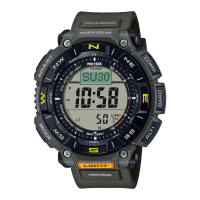
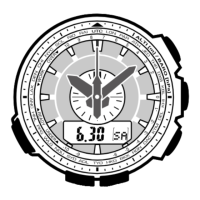
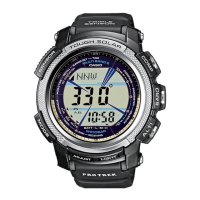
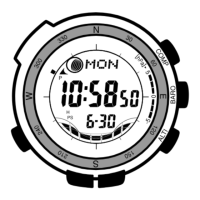
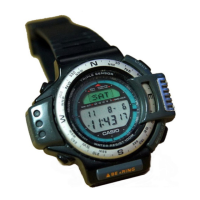
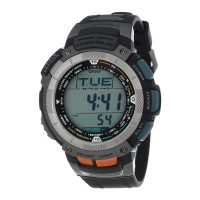
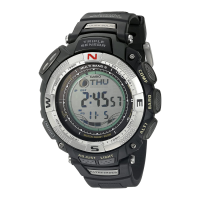
